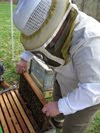 Here's a painting I did of a worker honey bee. Let's look at the different parts of her body.
Here's a painting I did of a worker honey bee. Let's look at the different parts of her body.Starting at the head you'll see she actually has five eyes and not just two.
Her compound eyes are for seeing in the day time. Her three small ocelli eyes are to see in the dark - like when the sun is setting and she's flying home loaded with nectar or pollen. Or she could be inside the hive where it's always dark and they help her see.
She has two antennae that are attached in the middle of her face. These are super sensitive and the bees use them for many things like smelling. They twitch and twirl their antennae a lot and it's interesting to watch them touching each other and their honeycombs with their antennae. When I watch them twitching their antennae it looks like they are talking with them.
A bee's mouth is really interesting. Bees have mandibles which are like two gates on hinges that come together in the middle. Her tongue is really long and soft. It's called a proboscis (say it like this: Pro-bow-sis). I'll cover the tongue in detail in another post but I want to clarify that bees can't really bite you. I mean they can bite, but their mouth is so small that they really wouldn't be able to get enough skin for you to feel it. Their stinger though is another matter.
Of course the female worker bee has a stinger, but she'll die if she uses it. Because of that honey bees don't like to sting unless they feel really threatened and think it's necessary.
Bees can be a golden or lighter yellow colour with brown to black stripes. They also have four wings, two on each side and she has two stomachs - one is a regular stomach for food and the other is a honey stomach where she stores either nectar or water that she brings back to the hive.
The honey bee is furry all over. She has hair on her back, her stomach, her legs and even in her eyes. These hairs are useful for two reasons. They keep her warm on colder days so she can fly out earlier in the morning and she can stay out later in the day. But more important, her fur is will collect and hold all the pollen when she goes into a flower.
That's she'll use her legs--she has six of them. Six legs means you're an insect. She'll sweep over her body, gathering up the tiny grains of pollen using her legs. Then she'll add some nectar to it to the powdery pollen make a slightly sticky damp mixture.
On her back legs are her pollen baskets - they're made up of a collection of stiff hairs. The worker bee will take the damp pollen mixture and stick it onto the stiff hairs kind of like how your hairs get caught in a brush when you brush your hair. Have you ever seen a honey bee or bumble bee with the yellow lumps on their back legs? That's their collected pollen stuck like suitcases on their back legs.
Once her baskets are loaded with pollen it's time for her to fly home to unload the food for her brothers and sisters to eat.



3 comments:
thanks for the information! It was very util.
Adriana :)
Really enjoyed this article! God has designed bees well!
Enjoyed this! God has designed bees well! See the book “A Closer Look at the Evidence “ by Kleiss (I think)
Post a Comment